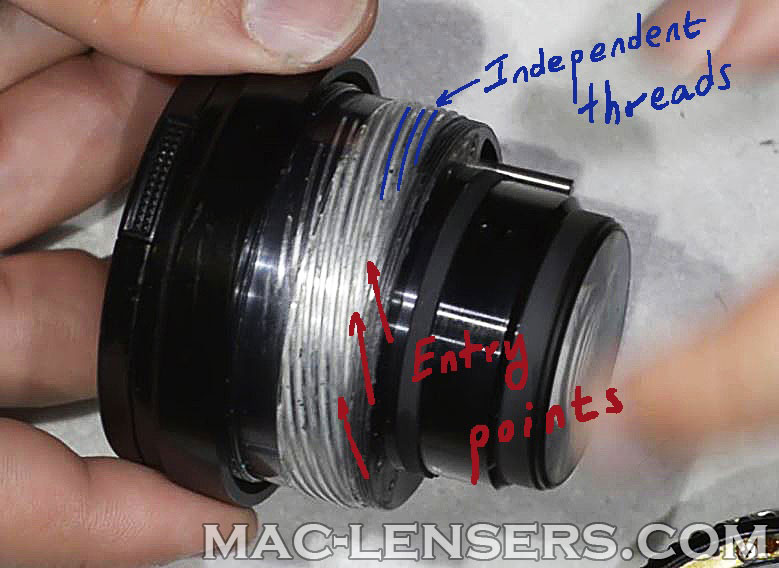Conjuntamente con
Pete Motitas
Publicado el
27/04/2022 a las 21:00.
Actualizado el 16/05/2022 a las 23:23.
Actualizado el 16/05/2022 a las 23:23.
For the sake of anonymity, the names have not been changed.
- Motitas : Good evening Peluca, what is the fundamental TOOL to succeed every lens repair?
- Peluca : mmmmmm, that would be patience and organization.
- Motitas : ..........you’re giving me nothing, I was expecting something more substantial.......come on, give me the real secret........
- Peluca : OK, the most fundamental thing you need to know to succeed in Lens repair is to know how to work with helicoids
- Motitas : Isn’t that the same thing as being patient and organized?
- Peluca : It is.
- Motitas : ................last time I tried that, I completely messed it up, got angry, and sold the lens on the internet for a few dollars...
- Peluca : You mean being patient and organized?
- Motitas : No, repairing a lens.....
- Peluca : What happened?
- Motitas : .... the focusing of my lens wasn't smooth. So I disassembled it.....
- Peluca : So, you managed.....
- Motitas : Not really, disassembly and cleaning went smoothly, but when I put the lens back together, it wasn’t as before
- Peluca : What do you mean it wasn’t as before?
- Motitas : I don’t know, the focusing ring wasn’t moving right and I was not able to get things in focus again.....and I swear I did not touch the optics
- Peluca : You probably messed with the helicoids assembly; did you marked the positions where helicoids separated?
- Motitas : Again that helicoids thing.........what’s so important about them, they’re just screws! ........I mean, you screw them, and you’re good to go.
- Peluca : Mmmmmm, No.
- Motitas : OK, Mr. Helicoids, please tell me what’s so great about these helicoids
- Peluca : A helicoid is just a screw with very large pitch. Think about a basic screw, you rotate it, it translates, and the pitch is the relation between rotation and translation. For example, a pitch of 1 millimetre means the screw is going to move 1 millimetre for one complete revolution. In general you need lots of rotations to perform a significant translation.
- Motitas : .....a-ha, you just said it, helicoids are just screws.....
- Peluca : Yes, I said it. But you’re forgetting about the screw pitch
- Motitas : So?
- Peluca : remember that time when your electric screwdriver ran out of battery and you had to finish assembling those drawers by hand?
- Motitas : My wrist certainly does.......it was painful..........but still I don’t see your point about the screw pitch
- Peluca : If the pitch is large, you only need little rotation to produce a big translation
- Motitas : You mean, half a twist and the screw gets in?
- Peluca : Yeah, something like that................. Now, some lenses use the same principle to perform focusing; you have a screw with a large pitch (i.e. the helicoid) and by rotating it the lens will move back and forth to produce images in focus.
- Motitas : Wow, what a great invention, but where is the catch?
- Peluca : The difference between standard screws and helicoids is that you usually perform less than one turn to perform a long translation. This means the thread usually does not complete a rotation about the barrel. So, to have a full threaded surface, several threads are machined into the barrel, and that is the fundamental difference between a screw and a helicoids, or the “catch” if you want. I made a picture for you.

- Motitas : still, this doesn't tell me why I wasn’t able to reassemble my lens
- Peluca : The fact that several threads are machined into the barrel is the thing that most people generally overlook and lead them to reassemble a lens incorrectly. You see, depending on your entry point, you may not finish in the position you think you are. As a result, the lens ends up super cheap on the internet.
- Motitas : Don’t tell me about it, had to sell my beautiful Nikkor 50 f/1.4 Ai-s for 20 bucks...
- Peluca : Ah, that was you........what a glorious day it was.........
- Motitas : Whaaaaaaaaaaaat?
- Peluca : Hey, It was a fair bid and I spent almost 2 hours fixing the mess you made. Also, I didn’t know you at the time.
- Motitas : Fair enough............2 hours you say, It couldn’t be that bad.........
- Peluca : Well, it is bad, because when you lose the “right” thread (or entry point), you’re on your own to discover how all those guys align together.
The only possible solution is trial and error, you try one thread, you check if mechanically you’re aligned, you fix, and test for focus at infinity. This takes time and never happens at once. So you disassemble, mark the current thread as bad and try a new one until you get it right. - Motitas : Ah yes, it's like with my pot of honey!
- Peluca : honeypot?
- Motitas : Yes when I take a pot of honey, or jam, before opening it there is a sticker that seals the lid on the pot. And by closing, depending on where I position my lid, I manage to reconstitute the sticker... or not...see, I made a picture

- Peluca : That's exactly the same principle!
- Motitas : On the other hand, my honeypot is closed every time. But my lens is not working, and all that because I assembled the lens on the wrong thread, right?
- Peluca : That’s quite a good summary to it.
- Motitas : Wow, it’s unbelievable that such a small thing makes such a big difference.
- Peluca : Like everything in life, it’s the small things that count.
- Motitas : Agree, agree.......you mentioned a few times focus at infinity, what it really means
- Peluca : Focusing at infinity is the closest distance between the optics and the film (or sensor) that lets objects far away to be focused.
The remaining distance, called the flange distance is given by the lens design and it is brand specific (for Nikon F-mount is 46.5mm). This explains why you cannot use for example Contax lenses (Flage 45.5mm) on your Nikon DSLR and get infinity focus, but that’s a different topic. - Motitas : So, even if you’re off by half a millimetre it’s not good
- Peluca : Even a tenth of millimetre is not good; a proper helicoids assembly should let you reach the designed flange distance of the lens.
- Motitas : Even badly mounted, I was able to get focus at close distance, let’s say 1 or 2 meters, and anyway, infinity is far away, so who cares?
- Peluca : As elements get close to the lens, their focusing point will move behind the focusing plane (film or sensor), and so, the lens needs to be moved forward so the image is in focus on the film plane.
A wrong helicoid assembly means most probably that the minimum position that can be reached is larger than the flange distance, and as explained before, the maximum focusing distance will be shorter than infinity.
Also, lenses are generally designed to assemble nicely when focused at infinity. If not well aligned, you’ll probably be able to assemble them, but their functionality will be greatly impaired. It was the case with your lens if I remember correctly - Motitas : All right, all right, you made your point. I understand the importance of knowing how to work with helicoids........
- Peluca : Good, do you have other questions..........?
- Motitas : Can I buy my lens back?


